Diseases of Hemp in Florida
THIS WEBSITE IS A WORK IN PROGRESS. WE ARE ADDING CONTENT DAILY.
In addition to insect pests, diseases are going to be an issue in the production of Industrial Hemp (Cannabis sativa) in Florida fields, shade structures and greenhouses.
This site is aimed at presenting information about Florida Hemp diseases and their management. New information will be provided as new diseases are identified and we learn more about their epidemiology. The University of Florida Pilot Program is instrumental in populating this information.
Making recommendations on how to manage the pathogens we discuss in this website will be forthcoming. Because this is a new crop and we have very little Florida data on how to manage them it will take a while to determine what is both effective and safe for the crop. We will use the FDACS Florida Pesticide List to determine which products we will evaluate. As you will see, there are 4 pages of products approved for use on hemp in Florida. This list will change over time, but it is all we have at this point. We can't evaluate all the materials listed and thus we will limit what we evaluate to products we have funding to evaluate or products that meet other criteria set my each of us who are planning to conduct such research.
Florida Pesticide List | Pesticide Brochure
Overview
THIS WEBSITE IS A WORK IN PROGRESS. WE ARE ADDING CONTENT DAILY.
In addition to insect pests, diseases are going to be an issue in the production of Industrial Hemp (Cannabis sativa) in Florida fields, shade structures and greenhouses.
This site is aimed at presenting information about Florida Hemp diseases and their management. New information will be provided as new diseases are identified and we learn more about their epidemiology. The University of Florida Pilot Program is instrumental in populating this information.
Making recommendations on how to manage the pathogens we discuss in this website will be forthcoming. Because this is a new crop and we have very little Florida data on how to manage them it will take a while to determine what is both effective and safe for the crop. We will use the FDACS Florida Pesticide List to determine which products we will evaluate. As you will see, there are 4 pages of products approved for use on hemp in Florida. This list will change over time, but it is all we have at this point. We can't evaluate all the materials listed and thus we will limit what we evaluate to products we have funding to evaluate or products that meet other criteria set my each of us who are planning to conduct such research.
Florida Pesticide List | Pesticide Brochure
Leaf spot diseases are common among hemp growers throughout the region, such as in Tennessee and Kentucky. Since the start of the (UF/IFAS) Industrial hemp pilot project there have been two confirmed fungal leaf spot diseases. Leaf spot (Curvularia pseudobrachyspora) and Cercospora Leaf Spot (Cercospora cf. flagellaris), the diseases were confirmed in June and March of 2020 respectively. As the project continues, we have seen more of these types of diseases, such as Septoria leaf spot and Bipolaris spp. The humid conditions of Florida favor the development of leaf spot diseases.
Symptoms of leaf spot diseases may vary, but are generally observed as small circular lesions with tan centers and brown margins to larger lesions to dark centers and brown/purple margins (UT Extension). Often, the lesions merge which can lead to blighting and in some severe cases can become yellow and cause defoliation of the hemp leaves.
More work is needed in this area to develop a better understanding of leaf spot diseases. It is important to remember that symptoms alone should not be used to diagnose, and you should always confirm with a diagnostic lab.
Leaf Spot – Curvularia pseudobrachyspora – 26 June 2020
This pathogen was first observed during a field trial in 2019. Leaf spot symptoms on some varieties were seen as high as 70%. The symptoms were typical of leaf spot with small yellow spots which became tan to brown with an accompanying yellow halo. The pathogen was observed on young and old leaves.
https://apsjournals.apsnet.org/doi/10.1094/PDIS-03-20-0546-PDN
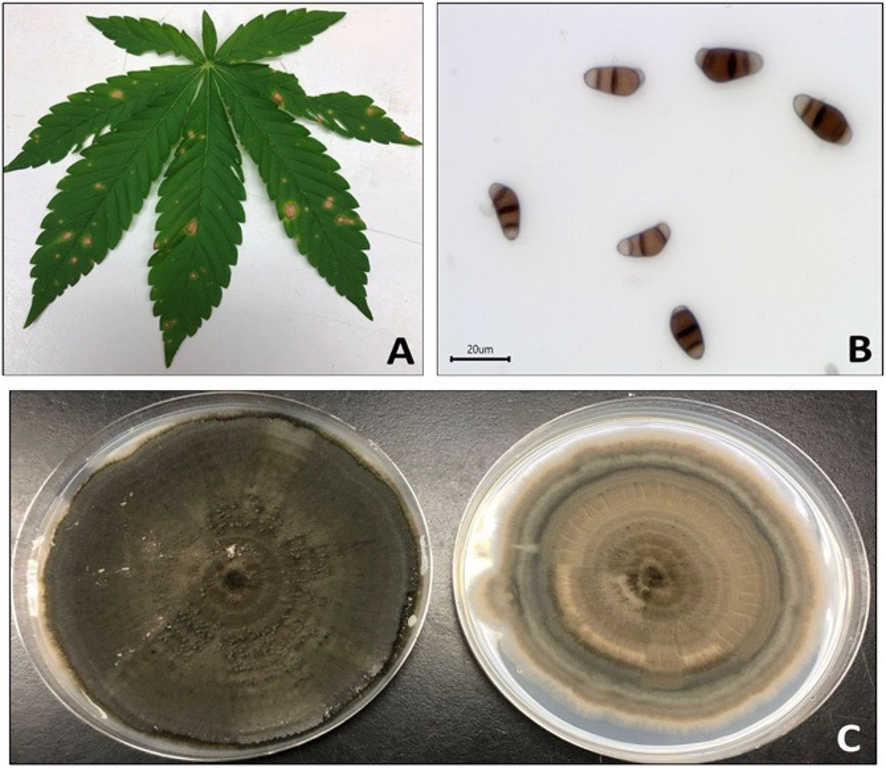
Photo Credit - Marin, Coburn, Desaeger and Peres. UF-GCREC, Wimauma, 2020. Infection of Curvularia pseudobrachyspora on hemp leaf and pathogen morphology. https://doi.org/10.1094/PDIS-03-20-0546-PDN
Cercospora Leaf Spot – Cercospora cf. flagellaris – 17 March 2020
This pathogen was first observed during a greenhouse and field trial in 2019. Leaf spot symptoms were seen on as high as 60% of the plant’s leaves. The symptoms were typical of leaf spot, beginning as small yellow flecks, developing into lesions which turned to light tan or white, with yellow halos, and in severe cases developing chlorosis, leading to defoliation. The infections began on older leaves and moved through the canopy.
https://apsjournals.apsnet.org/doi/10.1094/PDIS-11-19-2287-PDN
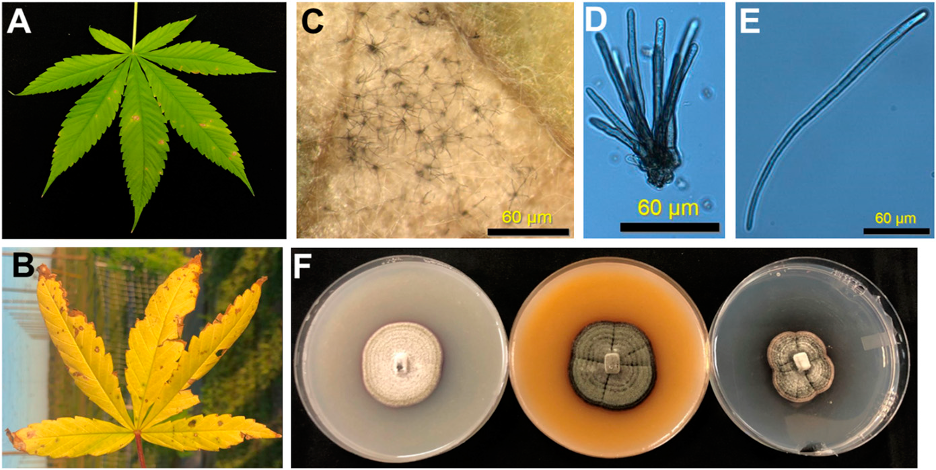
Photo Credit – Marin, Coburn, Desaeger and Peres. UF-GCREC, Wimauma, 2020. Infection of Cercospora cf. flagellaris on hemp leaf and pathogen morphology. https://doi.org/10.1094/PDIS-11-19-2287-PDN
Septoria Leaf Spot – Septoria sp.
Septoria leaf spot is one of the most common leaf spot pathogens among the hemp leaf spot diseases. Like other leaf spot pathogens, the symptoms of this disease begin in the lower canopy as small brown spots with yellow margins. The leaf spots may continue to grow, turn brown and coalesce. More advanced symptoms may be observed, such as leaf yellowing, stunting, and plant death. This disease can progress quickly during the summer months when there is excess moisture, humidity, and the canopies are more dense.
Management Considerations for Leaf Spot Diseases
At this time the best recommendation is to avoid susceptible cultivars. Research is ongoing to determine how to best manage these pathogens.
Powdery Mildew – Golovinomyces sp.
This disease is characterized by its white powdery appearance on the upper surface of the leaf. The powdery growth is made up of masses of fungi that give it its distinct appearance. Additional symptoms can include leaf necrosis and distortion, as well as early defoliation. The disease is common in both outdoor and greenhouse growing environments. High humidity and free water increase susceptibility to this disease. The pathogen is spread by spores that originate from infected tissue. The most common means of spore dispersal are through air currents.
Management Considerations for Powdery Mildew
At this time, cultural controls are the most effective way to manage Powdery Mildew. Specifically through the manipulation of the growing environment. The most effective cultural control strategy is to reduce humidity and moisture around and on the plant surface. This may be accomplished by increasing airflow around the plants to avoid areas of high humidity, and if possible, avoiding overhead irrigation.
Stem Canker – Diaporthe phaseolorum
This pathogen was first observed during a field trial in 2019. The symptoms observed with this disease were stem cankers. The symptoms began on the main stem as light-to-dark brown lesions of varying formations, eventually coalescing into larger necrotic areas. In this trial, at least 60% of three-month-old plants showed symptoms of this disease.
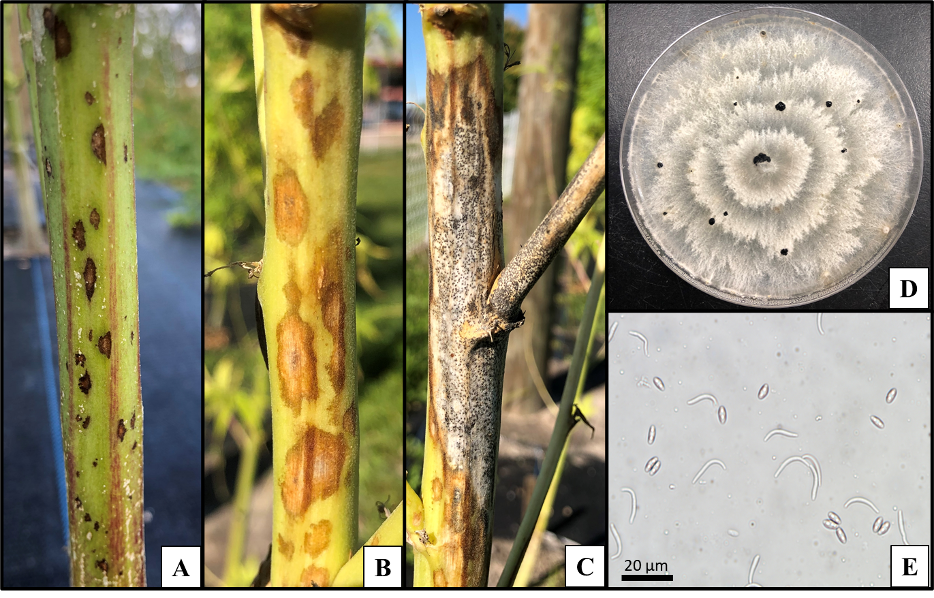
Photo Credit – Marin, Wang, Coburn, Desaeger, and Peres. UF-GCREC, Wimauma, 2019. Symptoms in different stages of disease development of hemp stem canker, caused by Diaporthe phaseolorum.
Management Considerations for Stem Canker
At this time, management of this disease may only be accomplished through resistant cultivars. Research is ongoing to identify more about management of this disease.
Gray Mold – Botrytis cinerea
The gray mold pathogen is one of the most important pathogens, as it is typically considered to be always present. Since this pathogen is rarely ever absent, it relies on wounds or natural openings to infect its host. The symptoms of this pathogen are often observed on the flower buds that are generally observed as having a gray moldy appearance. This fungus is very opportunistic, so any openings caused by pruning or insect damage are sites for possible infection. Other symptoms associated with this pathogen depend upon the site of infection, i.e. girdling and breaking of the stem. This pathogen may also cause damping off of seedlings in greenhouses, and is easily spread through the air.
Management Considerations for Gray Mold
While this pathogen can occur in field and greenhouse settings, it is favored by the high relative humidity inside greenhouses, which makes it a particularly important pathogen for indoor growers. This pathogen is very difficult to manage once it is found, but reducing air current after infection, sanitation afterwards are important to limiting the spread of the gray mold pathogen.
Soilborne & seedling diseases are caused by pathogens that live almost exclusively in the soil. Some of the diseases in this section are caused by true fungi, such as Southern Blight, while others are caused by Oomycetes, such as Pythium Root Rot. These diseases are usually very difficult to manage because they often exist conspicuously in the soil and can develop survival structures that exist in a field for many years. Some of these diseases may be managed by sanitation or cultural controls, such as crop rotations, while others are best managed through disease resistance.
The most common symptom associated with the diseases in this section is wilting. While wilting is not a diagnosis for soilborne diseases, it should not be ruled out. If any of the following disease are seen in a field, the most important thing to remember is to prevent any further spread of the pathogen, and always confirm with a diagnostic lab.
Southern blight – Sclerotium rolfsii
This disease can be extremely damaging and is marked by severe wilting which does not recover after watering. In addition to wilting, leaf yellowing is a common symptom of this disease. Due to the reproductive nature of this pathogen, it is common to see symptomatic plants next to healthy plants. This pathogen spreads through sclerotia, which are small, tan to brown, round balls that often resemble mustard seeds. These sclerotia are generally found in an accompanying white fungal growth, which can be observed at or near the soil surface, or on the crown of the plant. These survival structures are responsible for the disease’s longevity within a grower’s field.
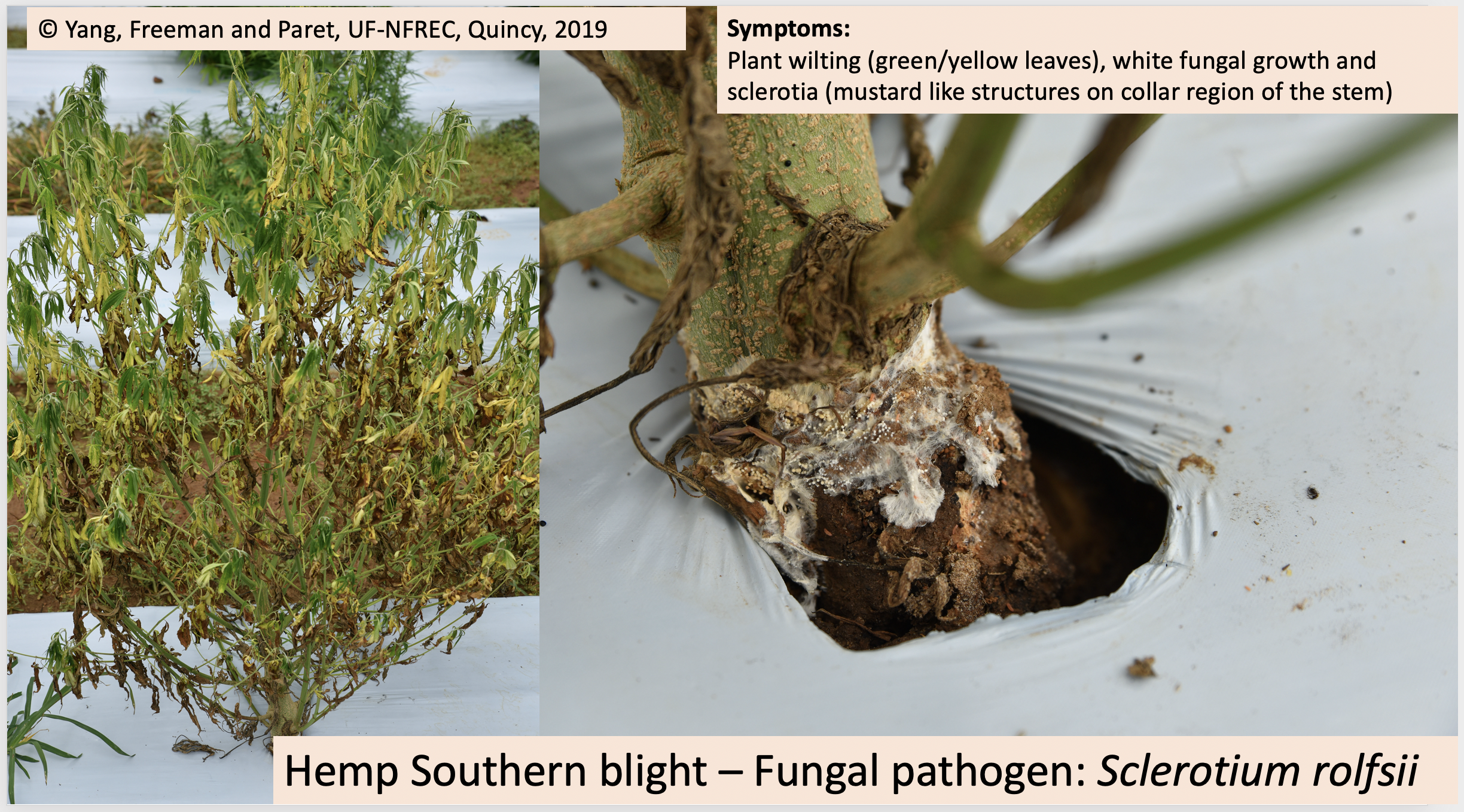
Photo Credit – Yang, Freeman and Paret, UF-NFREC, Quincy, 2019. Hemp Southern blight – Sclerotium rolfsii.
Management Considerations for Southern Blight
This pathogen survives as overwintering structures, called sclerotia, but does not spread easily without mechanical movement. Although, deep plowing may serve to bury the sclerotia deep in in the soil, but may just as easily spread the sclerotia throughout the field. It is common to rotate, often with grasses, or fallow for a period of years before replanting in a field that has been infested with this pathogen. But due to this pathogen’s ability to survive, it is likely that these fields may still be at high risk for this disease. Therefore, plants and soil immediately surrounding the plants with this disease should be carefully removed to minimize sclerotia.
Fusarium wilt and Crown Rot– Fusarium spp.
This disease is observed mostly in field grown hemp, and can be particularly devastating. Symptoms of this pathogen are characteristic of other Fusarium spp. diseases, and are most commonly observed as yellowing of leaves, and wilting, which will not improve with watering. Additionally, the vascular tissue within the crown, or stem near the soil line, will often show a brown discoloration. This pathogen is particularly difficult as it can remain in the soil for many years. Other diseases of this pathogen exist, but have yet to be observed in Florida.
Management Considerations For Crown Rot
At this time, there are a few species of Fusarium spp. that are known affect hemp. Like other Fusarium spp. diseases, crop rotation and planting resistant varieties are the most effective strategies. Ultimately, an integrated approach will be needed to manage this disease, but more research is needed to provide specific details, such as rotational crops and resistant varieties.
Pythium Root Rot – Pythium spp.
This disease is caused by a fungus like organism, often referred to as a water mold pathogen. And as the name implies causes root rot, which begins as necrosis on the feeder roots, ultimately progressing to the larger roots and causing them to turn black or brown. The roots ultimately become slimy, lose vigor, and develop a soft texture. In addition to below ground symptoms, often above ground symptoms such as leaf scorching and stunting, which often leads to plant death. This disease is particularly difficult as it is almost always present in soils, and like fungal organisms, develop survival structures allowing it to remain in the soil even during unfavorable conditions, but requires free water for movement to healthy plants.
Management Considerations for Pythium Root Rot
Since this pathogen is omnipresent in the soil, cultural considerations are the most important factor in management of this disease. And since it can be present in both outdoor and greenhouse grown hemp, particular attention needs to be paid to sanitation. Close attentions should be paid to any contaminated soil and water, as well as preventing movement of infected plants from greenhouses and previous years. Since this pathogen moves through water, runoff and infected irrigation water should be prevented. The most important aspect of managing this pathogen is to stop the introduction or infection, and maintain good plant health.
Damping-Off – Rhizoctonia solani
This disease is often associated with Pythium root rot, but unlike Pythium, this pathogen is a true fungi and has a different biology. The disease is most often a problem in seedlings and greenhouse grown plants. Symptoms may be observed as wilting or lesions around the crown of the plant, and a discoloration of the root system. Ultimately, this disease results in seedling death. Like other root rots, this disease is exacerbated by over irrigation and poor sanitation.
Management Considerations for Damping-Off
Management of this disease is also similar to Pythium, and should be managed in the same manner. Strategies to improve sanitation and reduce excess free water are the most important. Additionally, removal of diseased seedlings, contaminated trays and soil, is key in preventing the spread of this pathogen. It may also be necessary to remove the healthy seedlings next to infected ones as a precaution to prevent further spread.
Bacterial diseases are caused by bacterial microorganisms, which require free water for movement and to infect its host. Many bacterial diseases are observed as leaf spots, but they differ from fungal leaf spots in that the spots have a water soaked appearance, are generally vein limited, and often become necrotic and fall off the leaf.
Although relatively common on other crops, information regarding bacterial diseases on hemp is only minor at this time. Currently, in Florida, there is only one bacterial leaf spot disease being researched, Xanthomonas Leaf Spot caused by the pathogen Xanthomonas spp. More information will be provided as we learn more about these pathogens on hemp. If you suspect a bacterial leaf spot disease, always make sure to contact a diagnostic lab.
Xanthomonas Leaf Spot - Xanthomonas spp. –
Currently this disease is being researched, and more information will be provided as it becomes available.
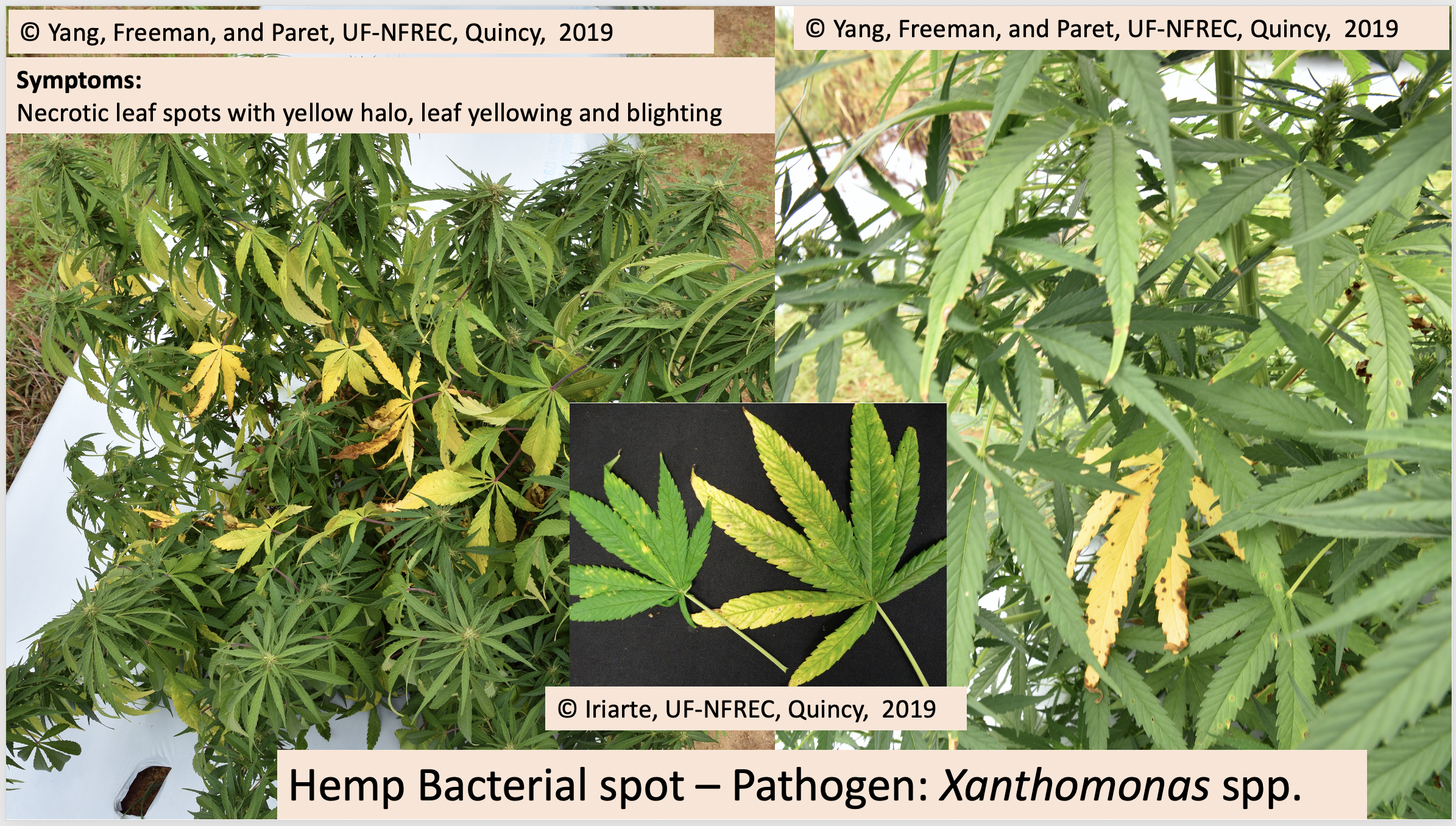
Photo Credit – Yang, Freeman and Paret, UF-NFREC, Quincy, 2019. Hemp Bacterial spot – Xanthomonas spp.
Management Considerations for Bacterial Diseases
While little is known on this pathogen’s management in hemp, general management strategies for Xanthomonas spp. can be applied. Some of these strategies may include avoiding any unnecessary wounding of the plant to prevent openings for which the bacteria can enter, and applying timely irrigation and avoiding overhead watering. Additionally, removing any plants that are suspected to be infected can help prevent the spread of this disease.
While viral diseases of hemp exist, at this time, viral diseases have been hard to determine as a causal agent. There have been reports of viral disease symptoms in hemp, but speculation still exists whether or not the virus is the cause of the disease. Additionally, those viruses that have been identified in hemp have been observed outside of North America. At this time, there is no conclusive evidence of viral pathogens causing diseases on hemp in Florida or North America.
Viral disease symptoms are often wide and varied, but are often associated with ‘streaking’ or an appearance of ‘mosaic’ like features. While these are classic symptoms, there are other diseases that may cause this effect. If you suspect that a virus is present in your field, it is important to contact a local extension agent and send a sample to a diagnostic lab.
Management Considerations for Viral Diseases
Viral diseases of hemp are most likely to be transmitted by vectors, such as insects, so management of these insects will be the key in managing these pathogens. We expect more information as researchers begin to understand the transmissibility of hemp viruses in nature.
There are many other diseases “to be on the lookout for” in Florida. While they have not been observed in Florida, they have been observed in many other states (e.g. KY, TN, NC) in the Southeast. It will be important to watch for these diseases and should you suspect that you have any of these diseases, please submit a sample to your local diagnostic center.
- Corynespora Leaf Spot – Corynespora sp.
- Hemp Leaf Spot – Bipolaris sp.
- Hemp Rust – Uredo kriegeriana
- Stem Canker – Phytophthora sp.
- Hemp Canker – Sclerotium sclerotiorum
- HLMV – Hemp Leaf Mosaic Virus






